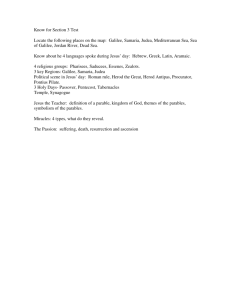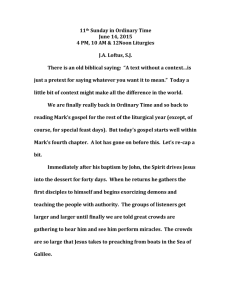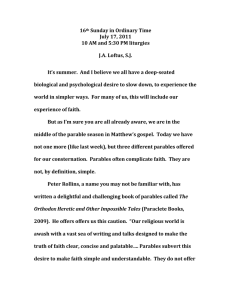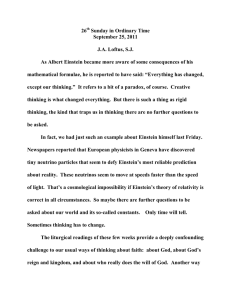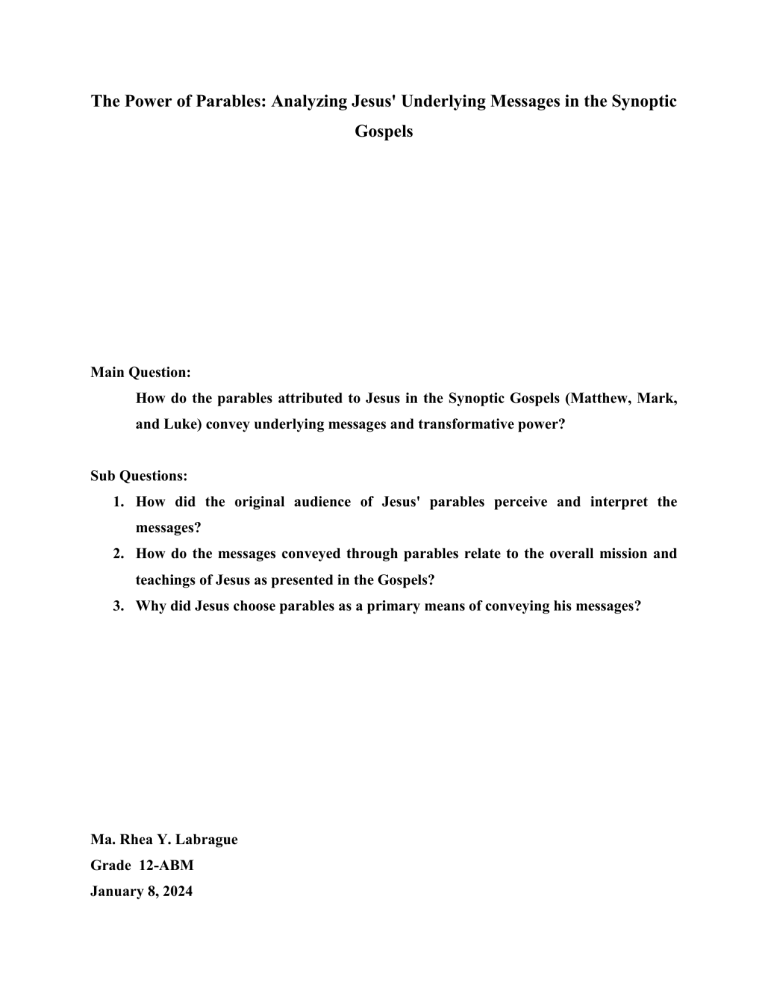
The Power of Parables: Analyzing Jesus' Underlying Messages in the Synoptic Gospels Main Question: How do the parables attributed to Jesus in the Synoptic Gospels (Matthew, Mark, and Luke) convey underlying messages and transformative power? Sub Questions: 1. How did the original audience of Jesus' parables perceive and interpret the messages? 2. How do the messages conveyed through parables relate to the overall mission and teachings of Jesus as presented in the Gospels? 3. Why did Jesus choose parables as a primary means of conveying his messages? Ma. Rhea Y. Labrague Grade 12-ABM January 8, 2024 Introduction Parables are brief stories with allegorical elements that use metaphors or symbols to teach spiritual or moral lessons. They frequently serve as an example of a moral or spiritual lesson, simplifying difficult concepts for a large audience. Parables are a storytelling technique used in many different cultures and religious contexts, but they are especially important when considering Jesus' teachings as they are reported in the Bible, particularly in the Synoptic Gospels (Matthew, Mark, and Luke). Parables are timeless testaments to wisdom, moral reflection, and spiritual guidance because they are woven throughout human history. These parables, which are taken from sacred books, have a deeper significance that cuts beyond their religious roots and appeals to all ages and cultures. Parables are more than just stories; as we investigate their meaning, we find that they are insightful analyses of morality, the human condition, and the never-ending search for meaning. Literary critic Erich Auerbach once said of the Bible: "It does not seek merely to make us forget our own reality for a few hours; rather, it seeks to overcome our reality: we are to fit our own life into its world, feel ourselves to be elements in its structure of universal history. Christians who tell these stories, rich, enigmatic, sometimes puzzling and ambiguous, can find that their lives fit into the world they describe -- in fact, that our stories suddenly seem more logical when viewed in that context. Parables act as mirrors, capturing the complexity of the human experience. Each parable encourages reflection and contemplation, whether it is through the Parable of the Good Samaritan, which questions social stereotypes, or the Parable of the Mustard Seed, which shows the transformational potential of modest beginnings. The underlying themes of morality, compassion, and the relationship between humans and the divine are timeless issues that are not limited to the historical setting in which they were spoken. The parables that Jesus told, as they are recorded in the Synoptic Gospels, are timeless sources of wisdom that encourage us to reflect on the universal lessons they teach and apply them to the constantly changing fabric of human experience. By realizing the significance of these parables, we set out on a journey that cuts across space, time, and cultural boundaries and learn about the enduring value of Jesus' underlying teachings for enhancing our individual lives and the well-being of humanity as a whole. Jesus, during a significant period of his ministry, extensively employed the powerful medium of storytelling, with parables becoming a central feature of his teachings. As Mark 4:34 emphasizes, "He did not say anything to them without using a parable," underscoring the prevalence and importance of this narrative form in conveying spiritual truths. Determining the exact count of parables in the Bible poses a challenge due to the subjective nature of categorization and the diverse forms of instructional narratives present in the scriptures. Some parables are explicitly labeled as such, while others, although not expressly identified, undeniably align with the essence of parabolic storytelling. The definition of a parable, when applied broadly to include various forms of parabolic instruction, can yield varying totals, with estimates ranging from about 100 to over 250 parables in the Bible.The Synoptic Gospels—Matthew, Mark, and Luke—record over 30 parables spoken by Jesus, providing a rich collection of these succinct yet profound stories. "This is why I speak to them in parables: 'Though seeing, they do not see; though hearing, they do not hear or understand,'" declares Jesus in Matthew 13:13. Jesus is explaining to his followers in this verse that he employs parables as a teaching aid. Parables are metaphors or short stories used to teach moral or spiritual lessons. Jesus engages his audience and invites them to ponder deeper meanings by presenting important truths through parables. "Though seeing, they do not see; though hearing, they do not hear or understand," is the second part of the verse that highlights the idea that some people may physically perceive the words and deeds of Jesus, but they may not understand the deeper spiritual or moral significance. It implies that in order to completely understand the lesson being communicated through the parables, one must have an open and compassionate heart. Jesus used this technique of instruction to separate those who came to him with closed hearts or preconceived ideas from those who sincerely wanted to understand his message. For those who were receptive to receiving them, the use of parables facilitated a deeper engagement with the teachings, inspiring contemplation and a clearer comprehension of spiritual truths. Indeed, the nature of a parable is such that it often invites the reader or listener to engage with the narrative and discern its underlying meaning. Jesus, in some instances, provided direct interpretations for certain parables, offering clarity on the intended lesson. However, in many cases, the responsibility of unraveling the deeper significance of the parables is left to the audience, requiring them to reflect and apply the teachings to their own lives. Even when Jesus' enemies were at odds with him, as depicted in Matthew 21:45-46, they often comprehended the intended message of his parables. This underscores the clarity of Jesus' communication, even if acceptance of the lessons varied among listeners. Catholic theologian Barbara E. Reid states that parables "break the structures of our accepted world, remove our defences and make us vulnerable to God." Through the use of parables, Jesus employed storytelling to unveil profound truths about the nature of God's kingdom. Simultaneously, he confronted and challenged the prevailing worldviews held by many of his contemporaries. In narrating these stories, Jesus went beyond mere entertainment; he intricately wove messages that cut through societal norms and religious expectations, aiming to transform hearts and minds. The relevance of Jesus' parables extends far beyond the historical crowds to whom he initially spoke. In a timeless manner, these narratives resonate with people of all eras, including our present day. By delving into the essence of his parables, Jesus continues to address and speak to each one of us, urging us to open our hearts and minds to the profound truths encapsulated within his messages. In engaging with Jesus' parables, we are confronted with an invitation to reevaluate our perspectives and preconceptions. The challenges embedded in these stories beckon us to reconsider our understanding of God's kingdom and the fundamental principles that underpin it. Much like the audiences of old, we are called to go beyond the surface of the narratives and delve into the deeper layers of meaning, allowing the transformative power of Jesus' teachings to shape our worldview. Following the delivery of the Parable of the Sower, a narrative found in the Synoptic Gospels (Matthew 13:3–23; Mark 4:2–32; Luke 8:4–15), Jesus encountered a question from his disciples before unveiling the interpretation. Their inquiry, captured in Matthew 13:10, sought insight into why Jesus chose to convey his teachings through parables when addressing the crowds. Although the exact motive behind the disciples' question remains unstated, one possible concern might have been their apprehension that the people were struggling to comprehend Jesus' profound teachings, as hinted in Mark 4:13. In response, Jesus provided a surprising and enlightening explanation for his use of parables. He asserted that the purpose of teaching in this symbolic and metaphorical manner was not to elucidate spiritual truths for the masses but rather to veil these truths from them. In Matthew 13:11, Jesus conveyed, "Because it has been given to you to know the mysteries of the kingdom of heaven, but to them it has not been given." In essence, he clarified that there was a deliberate distinction in the reception of spiritual insights between his disciples and the broader crowds. To emphasize this point, Jesus drew upon the Old Testament, specifically referencing the prophecy in Isaiah 6:9–10. According to Jesus, the veiling of spiritual truths from those who did not believe was a fulfillment of this ancient prophecy. Luke's account of the same discourse includes Jesus stating, "To you it has been given to know the mysteries of the kingdom of God, but to the rest it is given in parables, [so] that, 'Seeing they may not see, and hearing they may not understand'" (Luke 8:10; cf. Mark 4:11–12). This citation underscores Jesus' intentional use of parables as a means of both revealing and concealing spiritual insights, aligning with the divine plan and fulfilling prophetic scripture. In essence, Jesus' response highlights the dual purpose of his parabolic teachings: to grant a deeper understanding of the mysteries of the kingdom to his disciples while simultaneously veiling these truths from those who remained unbelieving. This approach aligns with a broader biblical narrative and emphasizes the sovereignty of God in the revelation of spiritual truths. REFERENCES: https://bibleproject.com/articles/are-the-parables-of-jesus-confusing-on-purpose/ https://hallow.com/blog/parables-ofjesus/#:~:text=With%20parables%2C%20Jesus%20told%20stories,our%20hearts%20to%20his %20message. https://www.gotquestions.org/parables-in-the-Bible.html https://cfc.sebts.edu/faith-and-culture/why-did-jesus-teach-in-parables/ Sacred Stories in Modern Times: The Biblical Relevance in Contemporary Society Main Question: How does Biblical narratives remain relevant over time? 3 Sub-questions: 1. How does Biblical narratives impact the modern society? 2. How does Biblical narratives contribute to the development of faith of society in today’s generation? 3. How important are Biblical narratives in shaping of norms in contemporary society? Ma. Rhea Y. Labrague 12-ABM December 05, 2023 Introduction Biblical narratives are timeless testaments to wisdom, moral reflection, and spiritual guidance because they are woven throughout human history. These Bible stories, which are taken from sacred books, have a deeper significance that cuts beyond their religious roots and appeals to all ages and cultures. Biblical stories are more than just stories; as we investigate their meaning, we find that they are insightful analyses of morality, the human condition, and the never-ending search for meaning. Literary critic Erich Auerbach once said of the Bible: "It does not seek merely to make us forget our own reality for a few hours; rather, it seeks to overcome our reality: we are to fit our own life into its world, feel ourselves to be elements in its structure of universal history. Christians who tell these stories, rich, enigmatic, sometimes puzzling and ambiguous, can find that their lives fit into the world they describe -- in fact, that our stories suddenly seem more logical when viewed in that context. Biblical narratives are based on a moral compass that has guided people and societies for centuries. These stories offer a wealth of lessons on justice, compassion, and the results of human actions, from the moral dilemmas faced by biblical characters to the moral lessons woven into parables. For example, the Ten Commandments provide a universal framework for moral behaviour that cuts across religious lines and is a timeless code of ethics. Biblical narratives frequently take the reader on journeys of transformation and atonement. Narratives of hope and renewal are found in the stories of characters such as Moses, who guided the Israelites towards freedom, and the prodigal son, who discovered forgiveness and reconciliation. They address the potential for human change, emphasising the transforming influence of forgiveness, faith, and the quest of morality. As repositories of timeless wisdom, these narratives transcend temporal and spatial boundaries, offering insights into the complexities of the human condition. Whether as sources of moral clarity, guides for personal transformation, or reflections on fundamental questions, biblical narratives stand as a testament to the enduring quest for meaning and purpose that unites humanity across diverse cultures and epochs. But comprehending how and why biblical narratives continue to be relevant in the face of swiftly changing society and the rise of various worldviews is a difficult and urgent task. In today's world, where people must navigate a global community that is interconnected, morality, justice, and purpose remain questions. In light of this, studying biblical stories offers us a window through which to examine not just their religious and historical significance but also their ongoing influence on the global ethos. The parables attributed to Jesus in the Synoptic Gospels (Matthew, Mark, and Luke) are short, narrative stories that convey deeper spiritual and moral lessons. These parables often use everyday situations and familiar imagery to communicate profound truths about the Kingdom of God, human nature, and the ethical teachings of Jesus. The transformative power of these parables lies in their ability to engage listeners, challenge assumptions, and invite reflection on one's beliefs and actions. Here are some ways in which the parables achieve this: Accessible Language and Imagery: Parables often use simple, relatable stories and common elements of daily life, making them accessible to a wide audience. This allows people from various backgrounds to grasp the messages without needing specialized knowledge. Provoking Thought and Reflection: The parables are crafted to provoke thought and selfreflection. By presenting situations that resonate with human experiences, they encourage listeners to contemplate their own lives, attitudes, and relationships. Challenge to Conventional Wisdom: Many parables challenge prevailing cultural norms and religious practices. They invite listeners to reconsider their assumptions and question established norms, encouraging a shift in perspective. Multilayered Meanings: Parables often have multiple layers of meaning. On the surface, they may address a specific context or issue, but beneath that, they convey deeper spiritual and moral truths. This allows individuals to discover insights at different levels of understanding. Inclusivity and Universality: The themes of love, forgiveness, compassion, and justice in the parables are universal, making them relevant across cultures and times. The inclusivity of these messages helps to create a sense of shared humanity and interconnectedness. Invitation to Participation: Rather than providing explicit answers, parables often leave room for interpretation. This invites listeners to actively engage with the material, seeking personal application and relevance in their own lives. Transformation of Hearts and Minds: The ultimate goal of the parables is to bring about a transformation in the hearts and minds of the listeners. Through the power of storytelling and the wisdom embedded in the narratives, individuals are encouraged to align their lives with the values of the Kingdom of God as taught by Jesus. Memorability: The memorable nature of parables makes them powerful teaching tools. People can carry these stories with them, allowing the lessons to resonate and influence their behavior long after hearing them. In summary, the parables attributed to Jesus in the Synoptic Gospels convey underlying messages and transformative power through their simplicity, relatability, challenge to conventional thinking, multilayered meanings, inclusivity, and the invitation for personal reflection and engagement. They serve as timeless vehicles for conveying profound spiritual truths and guiding individuals toward a deeper understanding of faith and ethical living. Jesus often used imagery and situations familiar to his audience, primarily comprised of Jewish people in a society influenced by Roman occupation and Jewish religious traditions.In essence, the original audience likely perceived Jesus' parables as thoughtprovoking, challenging, and relevant to their everyday lives. The parables served as a medium through which Jesus conveyed his teachings, encouraging the audience to reconsider their beliefs, values, and actions in light of the Kingdom of God. The multifaceted nature of the parables allowed for various levels of understanding and application among different individuals within the audience. Jesus frequently used parables as a teaching method, recognizing the power of storytelling to convey deep truths in a memorable and accessible way. This aligns with his broader mission to communicate profound spiritual truths in a manner that engages a diverse audience. the messages of Jesus' parables are intricately connected to the overarching mission and teachings presented in the Gospels. They provide a vivid and relatable means of communicating the values of the Kingdom of God, challenging societal norms, inviting personal transformation, and contributing to the broader ethical and spiritual teachings of Jesus. The parables, as part of Jesus' overall method of instruction, serve to illuminate and reinforce the core principles of his mission. Jesus chose parables as a primary means of conveying his messages because they were effective tools for communication in the cultural and social context of his time. The use of familiar language, engaging storytelling, and the ability to provoke thought made parables an accessible and impactful way to communicate profound spiritual and moral truths to a diverse audience. Parables are often open to interpretation and invite listeners to think deeply about their meanings. The ambiguity inherent in some parables encouraged individual reflection and engagement, fostering a more personal connection with the teachings. The memorable nature of parables facilitated retention and reflection. People could easily recall the stories and, in doing so, remember the teachings encapsulated within them. This made it more likely for the messages to endure and influence behavior over time.

